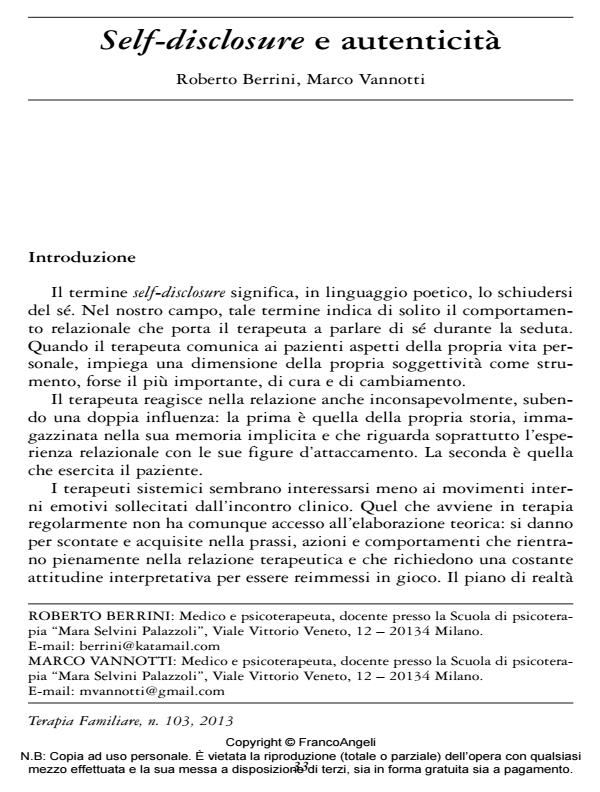Self-disclosure e autenticità
Journal title TERAPIA FAMILIARE
Author/s
Publishing Year 2014 Issue 2013/103
Language Italian Pages 17 P. 33-49 File size 153 KB
DOI 10.3280/TF2013-103003
DOI is like a bar code for intellectual property: to have more infomation
click here
Below, you can see the article first page
If you want to buy this article in PDF format, you can do it, following the instructions to buy download credits

FrancoAngeli is member of Publishers International Linking Association, Inc (PILA), a not-for-profit association which run the CrossRef service enabling links to and from online scholarly content.
The authors try to afford the issue of psychotherapist self-disclosure, first within systemic psychotherapy historic development and then within phenomenological tradition, that is, like a disposition to disclose oneself toward the world of others. The psychotherapist strains to achieve a subjective dimension of authenticity, in the meanwhile meeting with an analogous condition inside the patient mind, beyond the "technical" use of autobiographic skills. The foundation of this clinical component is endowed by the existence of the implicit side of the relatedness, built up from embodied sensory-motors drafts, stored in the attachment system procedural memory. In family therapy setting the psychotherapist can perceive resonances that are not carried by the declarative level of the relationships, but by attitudes, vocal tonalities, synchronies, that can drive him to support intersubjective moments between family members or between himself and family members.
Keywords: Self-disclosure, phenomenology, procedural memory – embodied sensory- motors drafts, attachment, family therapy
- Bowlby J. (1969). Attaccamento e perdita. L’attaccamento alla madre (trad. it.: Torino: Boringhieri, 1972).
- Bromberg P.M. (1998-2001). Clinica del trauma e della dissociazione (trad. it.: Milano, Raffaello Cortina, 2007.
- Caillé Ph., Selvini Palazzoli M. (2006). Familles et thérapeutes. Lecture systémique d’une interaction. Parigi: ESF.
- Elkaim M. (1989). Se mi ami, non amarmi (trad. it.: Torino, Bollati Boringhieri, 1992).
- Fivaz-Depeursinge E., Corboz-Warnery A. (1999). Il triangolo primario (trad. it.: Milano, Raffaello Cortina, 2000).
- Heidegger M. (1927). Essere e tempo (trad. it.: Milano: Mondadori, 2006).
- Liotti G. (2001). Le opere della coscienza. Psicopatologia e psicoterapia nella prospettiva cognitivo-evoluzionista. Milano: Raffaello Cortina.
- Mancia M. (2004). Sentire le parole. Torino: Bollati Boringhieri.
- Rizzolatti G., Sinigaglia C. (2006). So quel che fai. Milano: Raffaello Cortina.
- Selvini M. (2008). Undici tipi di personalità: l’interazione della diagnosi di personalità nel pensiero sistemico complesso. Ecologia della Mente, 31: 29-55. DOI: 10.1712/510.610
- Stanghellini G. (2006). Psicopatologia del senso comune. Milano: Raffaello Cortina.
- Stern D.N. (1998). The process of change study group: Non-interpretive mechanism in psychoanalytic therapy: the “something more” than interpretation. International Journal of Psychoanalysis, 79: 903-921.
- Stern D.N. (2005). Il momento presente. Milano: Raffaello Cortina.
- Vannotti M., Berrini R. (2009). L’essence relationnelle, nella monografia “Biologie et psychothérapie”. Cahiers critiques de thérapie familiale e de pratiques de réseaux, 43: 97-116.
, Self-disclosure e autenticità in "TERAPIA FAMILIARE" 103/2013, pp 33-49, DOI: 10.3280/TF2013-103003